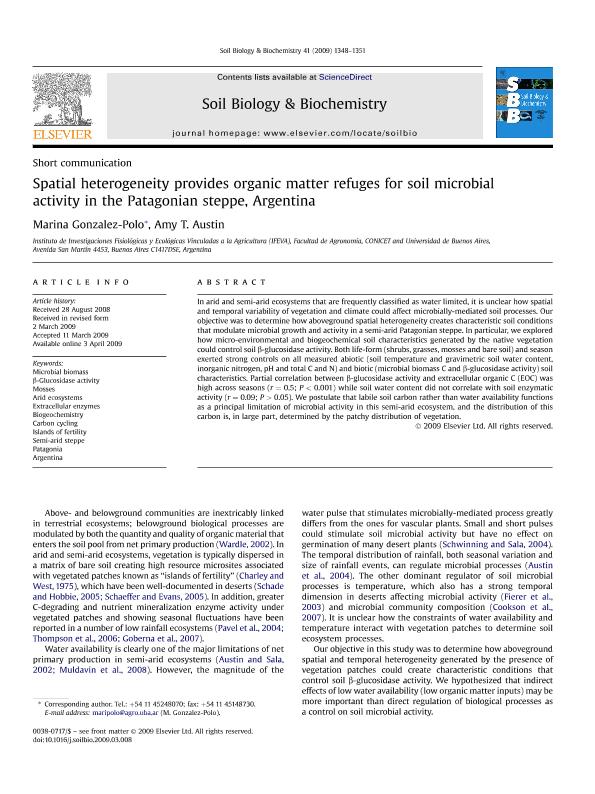Artículo
Spatial heterogeneity provides organic matter refuges for soil microbial activity in the Patagonian steppe, Argentina
Fecha de publicación:
06/2009
Editorial:
Pergamon-Elsevier Science Ltd
Revista:
Soil Biology And Biochemistry
ISSN:
0038-0717
Idioma:
Inglés
Tipo de recurso:
Artículo publicado
Clasificación temática:
Resumen
In arid and semi-arid ecosystems that are frequently classified as water limited, it is unclear how spatial and temporal variability of vegetation and climate could affect microbially-mediated soil processes. Our objective was to determine how aboveground spatial heterogeneity creates characteristic soil conditions that modulate microbial growth and activity in a semi-arid Patagonian steppe. In particular, we explored how micro-environmental and biogeochemical soil characteristics generated by the native vegetation could control soil β-glucosidase activity. Both life-form (shrubs, grasses, mosses and bare soil) and season exerted strong controls on all measured abiotic (soil temperature and gravimetric soil water content, inorganic nitrogen, pH and total C and N) and biotic (microbial biomass C and β-glucosidase activity) soil characteristics. Partial correlation between β-glucosidase activity and extracellular organic C (EOC) was high across seasons (r = 0.5; P < 0.001) while soil water content did not correlate with soil enzymatic activity (r = 0.09; P > 0.05). We postulate that labile soil carbon rather than water availability functions as a principal limitation of microbial activity in this semi-arid ecosystem, and the distribution of this carbon is, in large part, determined by the patchy distribution of vegetation.
Archivos asociados
Licencia
Identificadores
Colecciones
Articulos(IFEVA)
Articulos de INST.D/INV.FISIOLOGICAS Y ECO.VINCULADAS A L/AGRIC
Articulos de INST.D/INV.FISIOLOGICAS Y ECO.VINCULADAS A L/AGRIC
Citación
Gonzalez Polo, Marina; Austin, Amy Theresa; Spatial heterogeneity provides organic matter refuges for soil microbial activity in the Patagonian steppe, Argentina; Pergamon-Elsevier Science Ltd; Soil Biology And Biochemistry; 41; 6; 6-2009; 1348-1351
Compartir
Altmétricas




